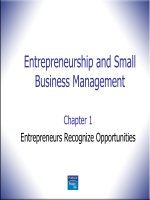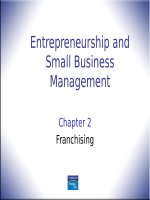Entrepreneurship and small business management chapter 14
Bạn đang xem bản rút gọn của tài liệu. Xem và tải ngay bản đầy đủ của tài liệu tại đây (107.01 KB, 22 trang )
Entrepreneurship and
Small Business
Management
Chapter 14
Cash Flow and Taxes
Ch. 14 Performance
Objectives
Understand the importance of cash
flow management.
Know the difference between cash
and profits.
Read a cash flow statement.
Create a cash budget.
File appropriate business tax returns
for your business.
Entrepreneurship and Small Business
Management, 1/e
2
© 2012 Pearson Education, Upper Saddle River, NJ
07458.
Cash Flow Is Critical
Cash flow refers to money coming
in and going out of your business.
Without cash on hand, your
business will not be able to pay
crucial bills.
Goal: Never have a negative cash
balance.
Entrepreneurship and Small Business
Management, 1/e
3
© 2012 Pearson Education, Upper Saddle River, NJ
07458.
Tracking Cash Flow
Income statement is poor gauge of cash
flow.
Showing a profit does not mean adequate
cash is on hand, due to lag time between…
…making sales and receiving customer payments.
…paying for labor/materials and receiving finished
goods.
Noncash expenses, such as depreciation, can
distort the picture.
Cash flow statement shows inflows and
outflows of money as they occur.
Entrepreneurship and Small Business
Management, 1/e
4
© 2012 Pearson Education, Upper Saddle River, NJ
07458.
Rules to Keep Cash Flowing
Collect cash as soon as possible.
Pay your bills by the due date, not earlier.
Check your available cash every day.
Lease or finance instead of buying
equipment, where practical.
Avoid buying inventory that you do not
need.
Entrepreneurship and Small Business
Management, 1/e
5
© 2012 Pearson Education, Upper Saddle River, NJ
07458.
Keep an Eye on Working
Capital
Working capital equals:
Current assets minus current liabilities
Amount of cash that would remain if all
short-term debt was paid with the cash on
hand
If a firm runs out of working capital, it:
Will not be able to spend the cash needed to
bring a new product to market
Will still have ongoing bills to pay
May not be able to stay in business
Entrepreneurship and Small Business
Management, 1/e
6
© 2012 Pearson Education, Upper Saddle River, NJ
07458.
Cycles That Affect Cash Flow
Transaction cycles—based on operations
A manufacturer may have to pay its suppliers
and employees before getting paid by customers.
A residential cleaning firm may collect customer
payments on the same day as service is
provided.
Seasonal cycles—based on time of year
A flower store may have more cash around
holidays but less at other times.
A college bookstore has more cash after school
starts but less when it has to buy the inventory.
Entrepreneurship and Small Business
Management, 1/e
7
© 2012 Pearson Education, Upper Saddle River, NJ
07458.
The Cash Flow Statement
Sections of statement:
“Inflows” (cash receipts)
“Outflows” (cash disbursements)
Net change in cash flow
Categories of inflows and outflows:
Operations
Investment
Financing
Entrepreneurship and Small Business
Management, 1/e
8
© 2012 Pearson Education, Upper Saddle River, NJ
07458.
Sample Cash Flow Statement
Cash Flow for Tom’s Custom Blinds, Month of June 2011
Cash Inflows—Operations:
Sales (net of returns)
$65,400
Total cash inflows
$65,400
Cash Outflows—Operations:
Variable costs:
COGS
$29,360
Other (commissions)
$6,540
Fixed costs:
Factory rent & utilities
Sales and
administrative
$12,000
Taxes
$2,875
Total cash used in
operations
Entrepreneurship and Small Business
Management, 1/e
Net Cash Flow from
$8,000
$58,775
9
© 2012 Pearson
Education,
Saddle River, NJ
($65,400
– Upper
$58,775)
$6,625
07458.
Sample Cash Flow Statement
(cont.)
Cash Flow for Tom’s Custom Blinds, Month of June 2011
Cash Outflows—Investing:
Purchase of Building
$0
Purchase of Equipment
$7,000
Net Cash Flow from
Investing
$7,000
Cash Inflows—Financing
Loans
$20,00
0
Gifts
$300
Equity Investment
$0
Net Cash Flow from
Financing
$20,30
0
Net Increase/(Decrease) in
Cash
Entrepreneurship and Small Business
Management, 1/e
Cash, Beginning:
10
$20,67
5
($6,625 – $7,000 +
$20,300)
© 2012 Pearson Education, Upper Saddle River, NJ
07458.
$500
Steps to Forecast Cash
Flow
1. Project cash receipts from all possible
sources.
Includes cleared checks, credit card
payments, and cash itself (no orders)
Note assumptions made when estimating
2. Subtract expenses that must be paid
during the forecast time period.
Entrepreneurship and Small Business
Management, 1/e
11
© 2012 Pearson Education, Upper Saddle River, NJ
07458.
Managing Inventory
to Manage Cash
Inventory creates risk because it might not
be sold at a profit.
Sell inventory at a price that covers COGS,
storage costs, and pilferage (theft), and still
earn a profit.
Keep timely and accurate inventory records.
Control stock levels to minimize amount of
cash tied up in inventory, and prevent
waste.
Entrepreneurship and Small Business
Management, 1/e
12
© 2012 Pearson Education, Upper Saddle River, NJ
07458.
Managing Receivables
to Manage Cash
Bill and collect monies owed to your
business, in a timely manner.
Use Aging Schedule to track
Accounts Receivable and estimate
cash flow.
Consider factoring—receivables
financing.
Entrepreneurship and Small Business
Management, 1/e
13
© 2012 Pearson Education, Upper Saddle River, NJ
07458.
Managing Accounts
Payable
to Manage Cash
Use credit (the ability to borrow
money) wisely.
Negotiate favorable payment
terms when opportunities arise.
Track payables with an Aging
Schedule.
Entrepreneurship and Small Business
Management, 1/e
14
© 2012 Pearson Education, Upper Saddle River, NJ
07458.
Capital Budgeting and Cash
Flow
Capital assets affect cash outflows when
purchased and cash inflows when liquidated.
Use capital budgeting to understand the cash
flow required for investments and the
expected impact on operating cash flows.
Calculate depreciation associated with capital
investment to anticipate the tax effects.
Plan and analyze each potential capital
project separately to determine feasibility.
Entrepreneurship and Small Business
Management, 1/e
15
© 2012 Pearson Education, Upper Saddle River, NJ
07458.
Burn Rate
Pace at which your company will need to
spend capital to cover overhead costs
before generating a positive cash flow
(Cash Available + Revenue)
Negative Cash Outflow per Month
= Number of Months Before Cash Runs Out
Entrepreneurship and Small Business
Management, 1/e
16
© 2012 Pearson Education, Upper Saddle River, NJ
07458.
The Time Value of Money
Future value—amount it will accrue
(gain) over time through investment
Present value—amount an investment
is worth discounted back to the present
Reasons to have your money “now”:
Inflation
Risk
Opportunity
Entrepreneurship and Small Business
Management, 1/e
17
© 2012 Pearson Education, Upper Saddle River, NJ
07458.
Self-Employment Tax is:
A federal tax that business owners pay on
the wages paid to themselves
The Social Security tax obligation for those
who are self-employed
The combined equivalent of the employee
and employer taxes paid for employees
Paid quarterly, so cash should be put aside
for making payments on the due dates
Entrepreneurship and Small Business
Management, 1/e
18
© 2012 Pearson Education, Upper Saddle River, NJ
07458.
Income and Sales Taxes
Entrepreneurs pay income tax to
federal and state governments.
Businesses are also subject to local
taxes.
Tax returns must be filed (mailed or
submitted online) by specific dates
each year.
In most states, if you sell products or
services to the public, you must collect
sales tax and submit it quarterly.
Entrepreneurship and Small Business
Management, 1/e
19
© 2012 Pearson Education, Upper Saddle River, NJ
07458.
Tax Issues Vary By Legal
Structure
Sole proprietorship—all profits reported
as personal income by owner
Partnership—profits and losses are shared
by partners and reported on their individual
tax returns
Limited partnership—similar to a
partnership except losses can be used as a
tax shelter without exposure to personal
liability
Entrepreneurship and Small Business
Management, 1/e
20
© 2012 Pearson Education, Upper Saddle River, NJ
07458.
Tax Issues Vary By Legal
Structure
(continued)
C corporation—has “double” taxation:
Profits are taxed whether or not a share of the
profits is distributed to the owners.
Owners also pay personal income tax on any
profit distribution they receive.
S corporation—profit is taxed only once,
as owner income on personal tax returns
Limited liability company (LLC)—
separates the owner/partners from
personal liability
Entrepreneurship and Small Business
Management, 1/e
21
© 2012 Pearson Education, Upper Saddle River, NJ
07458.
How to Avoid Tax Problems
Keep accurate financial records
throughout the year.
Store all ledgers, receipts, and invoices
in an organized manner.
Hire a tax accountant or attorney as a
consultant.
If you prepare your own tax returns:
Purchase tax software.
Ask a tax professional to review your
paperwork.
Entrepreneurship and Small Business
Management, 1/e
22
© 2012 Pearson Education, Upper Saddle River, NJ
07458.









